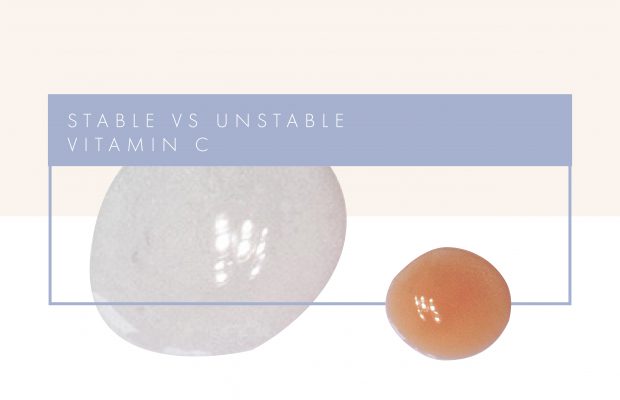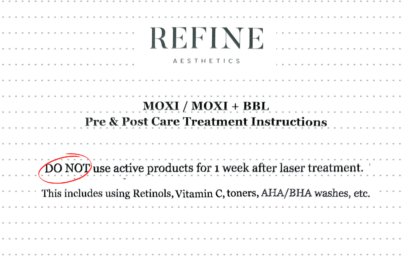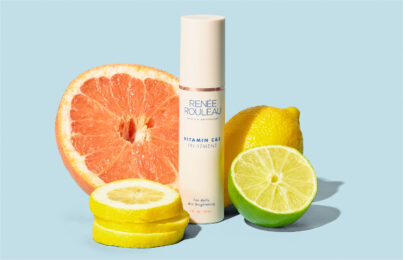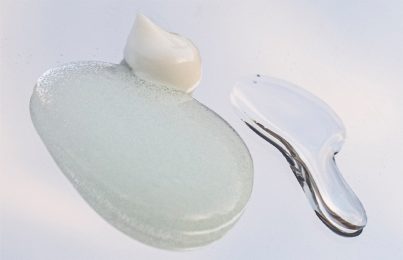Updated 02/08/22. If you’re an avid user of advanced skincare products, then surely you’re using (or have used), a vitamin C serum to provide your skin with antioxidants that can protect it from environmental damage. I know I do. I apply the Vitamin C&E Treatment under moisturizer/sunscreen every single day, and I consider it to be one of the best ways to slow down the progression of visible signs of aging.
However, not all vitamin C serums are equal. Some of them are formulated with unstable forms of vitamin C, which oxidize quickly and lose efficacy. How can you tell if this has happened to your vitamin C serum? A surefire sign is if it turns a copper-brown color. Keep reading to learn more—including how vitamin C works, why you should be using it, and what you should do if your vitamin C serum has changed color.
How Vitamin C Works and Why It’s Beneficial to the Skin
One of the main reasons we age (and therefore our skin ages) is because of free radicals. These are unstable molecules that attack healthy cells by attaching to the DNA, lipids, and proteins inside of them, which causes them to function abnormally (or not at all). This slows down the production of collagen and elastin, which are both essential in keeping the skin firm and unwrinkled. It can also lead to premature cell death. Gradually, signs of aging become apparent, and we start to see brown spots, wrinkles, and sagging skin appear.
That’s where antioxidants come in. Antioxidants, such as stabilized vitamins C and E, can prevent free radicals from oxidizing molecules and causing damage, which means they can effectively slow down the aging process. For an example of this, all you have to do is take a bite of an apple (yes, really!). When you bite an apple and leave it sitting on your kitchen counter for as little as 30 minutes, the inside of the apple will start to oxidize and turn brown. If you sprinkle some lemon juice on it, however, it will prevent oxidation and maintain its freshness. Lemon juice is high in vitamin C and is therefore considered an antioxidant. Vitamin C serums work the same way for your skin. They can help keep cells fresh and youthful.
Note: Never put pure lemon juice on your skin, as it contains other compounds that are photo-toxic, meaning it can leave skin susceptible to damage from light. It can also be highly irritating. Use a well-formulated topical vitamin C serum instead.
To see proof that vitamin C really works, check out this experiment.
What It Means When a Vitamin C Serum Turns Brown
When a vitamin C serum turns brown, it means it has oxidized, and thus, has lost its efficacy. If this happens to your vitamin C serum, it’s time to toss it and find another, stable formula to use. For a visual demonstration of oxidized vitamin C, just look at the picture above. I used two bottles of a popular vitamin C serum to demonstrate this (L-ascorbic acid, to be specific). The serum on the left is a drop from a new bottle. You can see that it’s colorless. The serum on the right is a drop from a three-month-old bottle. You can clearly see that it has oxidized and turned a copper-brown color. When this happens, it’s safe to say that it no longer has active vitamin C in it, so it’s no longer effective.
What Happens If You Use a Vitamin C Serum That Has Turned Brown
If you continue to use a vitamin C serum that has turned brown, you could be doing more harm than good to your skin.
- It can cause dryness, sensitivity, and irritation. Brown vitamin C has a high acid content and a low pH, which means it can cause stinging on application and lead to a whole host of skin issues, including dryness, sensitivity, and irritation (yikes!).
- It can cause blackheads. Brown vitamin C serums can cause oxidation to the oil on the top of the pore opening, which can lead to visible blackheads.
Simply put, if you’re using a product that has gone from light to dark, you’re not getting your money’s worth and therefore, you’re not getting the best results in skin brightening and anti-aging protection. It only makes sense to avoid using the type of vitamin C that is so highly unstable and find a more effective formula, especially if you have sensitive skin.
Stable Forms of Vitamin C
The following forms of vitamin C are considered stable and won’t lose efficacy or irritate sensitive skin like other forms can.
- Magnesium Ascorbyl Phosphate (also a proven skin lightener to fade brown spots and discoloration from age, sun, breakouts, and hormones)
- Tetrahexyldecyl Ascorbate
- Ascorbyl Methylsilanol Pectinate
- Ascorbyl Palmitate
- Sodium Ascorbyl Phosphate
- Ascorbyl Glucoside
- 3-O-Ethyl Ascorbic Acid
Unstable Forms of Vitamin C
- Ascorbic Acid (this is often written as L-Ascorbic Acid on ingredient labels)
The Bottom Line
When used exclusively in skincare formulas as the main form of vitamin C (listed within the top five ingredients on the bottle), these forms of vitamin C will not only oxidize (and quickly!), but they can also irritate sensitive skin types. That’s why, when it comes to choosing a vitamin C formula, you should do so carefully. After all, you want to get the best results for your skin and you want to get your money’s worth!
The Vitamin C&E Treatment contains both lipid and water-soluble forms of vitamin C to deliver antioxidant effects deep within the epidermal layers. It contains a mix of Tetrahexyldecyl Ascorbate, Ascorbyl Methylsilanol Pectinate, and Kakadu Plum (which has 100 times more vitamin C than an orange). It’s a stable formula that, when used daily, can lead to brighter, fresher skin!
Next, read up on the five things you should look for in a vitamin C serum!
Celebrity Esthetician & Skincare Expert
As an esthetician trained in cosmetic chemistry, Renée Rouleau has spent 35 years researching skin, educating her audience, and building an award-winning line of products. Her hands-on experience as an esthetician and trusted skin care expert has created a real-world solution — products that are formulated for nine different types of skin so your face will get exactly what it needs to look and feel its best. Trusted by celebrities, editors, bloggers, and skincare obsessives around the globe, her vast real-world knowledge and constant research are why Marie Claire calls her “the most passionate skin practitioner we know.”




Comments:
Hi Renee, I was recently looking into purchasing a vitamin c serum from a dermatologist in california that has her own spa and makes her own skincare. It is 15% L-asorbic acid (first ingredient) and says it comes in a transdermal delivery system with the air tight pump, and also has plant stem cells and other antioxidants. Its at a ph of 3.0. It sounds promising but im so leery of it oxidizing or something. Is 3.0 the right ph and do you think this would be good? Id really like to get ahold of some L-ascorbic acid bc I need some strong collagen building stuff for my face. Please let me know your thoughts.
Posted By: claire |
Wow, that pH is extremely low, even lower than most exfoliating acid serums so if your skin is sensitive, more than likely you’ll be getting dryness and irritation. Plus with is being so low, it’s definitely going to oxidize the minute it gets applied to your face. My Vitamin C&E Treatment is a pH of 6.8 so you can see how different a stable form is from an unstable form. Read this post to learn more about the different types of vitamin C.
Posted By: Renée Rouleau |
Thanks Renee! okay, so I purchased several of your products yesterday including cleanser, toner, vitamin c& e treatment, bio radiance serum, moisturizer and total eye repair cream. my next question is when do I apply the eye cream in my skincare lineup? I want to make sure everything is getting absorbed. The eyes is where I really need help. I have crows feet, fine lines and a few deep wrinkles. thanks again! 🙂
Posted By: claire |
I am new to using vitamin c and I recently purchased a serum from a spa that creates their own formula. I purchased a bottle and the serum is brown/Orange. I contacted the owner and creator of the serum and asked her about it since everything I’ve read says those colors indicate oxidation. She said her formula starts out brown and it all depends on how the vitamin c is derived and what it’s mixed with. Is this true?
Posted By: Layne |
It’s hard for me to comment on a product that I’m not familiar with but you might inquire as to why the product is brown/orange. Meaning, if oxidation is not occurring, then ask what ingredient makes it that color. To the best of my knowledge, all types of vitamin C start out as clear but maybe she uses some other ingredient mixed with it that is giving it that color. I’m trying to think off the top of my head as to what types of ingredients give that kind of color and the only ones that come to mind right now are chinese licorice (lichochalcone) and tea tree oil (more of a yellow-ish tone). Caramel is also an ingredient used as a coloring agent in skin care products which could give a orange/brown kind of color.
Posted By: Renée Rouleau |
Thank you! I’ll ask about that
Posted By: Layne |
Let me know what you find out. I’m curious, too.
Posted By: Renée Rouleau |
The ingredient list is rubbing off the the bottle but I could make out Aloe leaf extract, purified water, ascorbic acid, propyl PEG, lemon peel extract and Humulus.
Posted By: Layne |
For starters, this label is not in compliance with the FDA. For example ingredient “humulus” has to be listed as its proper INCI name of “Humulus Lupulus (Hops) Extract” so this doesn’t give me a lot of confidence in the product. Some of the others are listed incorrectly as well. From what I can see, ascorbic acid is what is turning it brown as in its pure form, it will turn darker in color with time. You are much better off using a stable form of vitamin C like this one, and one that is following the rules put out by the FDA related to skincare labeling.
Posted By: Renée Rouleau |
Thank You for your help. I just didn’t feel good about it in my gut which is why I was doing all the research. I will defiantly be using a different product. Just wish I hadn’t wasted my $… Oh well, live and learn right?!
Posted By: Layne |
Hi. I bought Oz naturals vitamin c serum about 3 months ago but didn’t open the sealing yet, the expiry date is July 2016 but I did open today and realized that the serum had turned thick and brownish. I’m not sure if my friend kept it where a room was heated or what could have caused it to become like that. I’ve just done a laser treatment on my face and I mixed the vitamin c serum with Vaseline. Is it still safe to use?
Posted By: Jess |
Do you know if it’s supposed to be thick and brown if you have never opened it before? But if you know for sure that it’s not supposed to be that way, then the product has drastically oxidized and altered and I wouldn’t recommend using it.
Posted By: Renée Rouleau |
Is the product in the example the C E Ferulic from SkinCeuticals (packaging looks similar)? I recently purchased it and was told to expect darkening. Please advise if able to!
Posted By: Rachel |
Yes, it is that product.
Posted By: Renée Rouleau |
Which Vitamin C Serum product would you recommend?
Posted By: Tina Aviles, |
Hi Tina, I recommend Vitamin C&E Treatment to all my clients. You can see it here.
Posted By: Renée Rouleau |
I bought powered L- absorbic to make my own cream. But I’ve noticed after application a couple of hours later, my pores turned black and my hands were orange.. Is that normal?as it has come in contact with the air?
Posted By: Raechell |
That’s a sign of a highly unstable formula. What happened is that the vitamin C penetrated into your pores and the formula oxidized over time and turned dark on your skin–and hands. It can’t benefit your skin if it’s oxidizing so rapidly. Read this post to show what a stable formula can do.
Posted By: Renée Rouleau |
Hi, I have a tube of Vitamin C cream from a highly regarded French pharmacy brand. When it comes out of the tube, it looks pale yellow and fresh but the old cream that’s collected around the nozzle is brown. I guess that’s normal?
Posted By: Anjali |
Yes, that is normal. Oxidation has occurred due to the air getting to the product in that area.
Posted By: Renée Rouleau |
I respectfully disagree with your view of vitamin c’s used in serums. through research done at Duke Univeristy, only L-ascorbic acid ( as long as it in the right percentage, PH, and pure form) is able to get into the skin to do the job we want it to do. this has been studied and published many many times. – as a consumer always look for credibility on ANY skin care product. what are the facts? is the science peer reviewed? has the science been published in reputable journals? – vitamin C is everywhere in skin care ranging from 20$ to 160$. you get what you pay for!
Posted By: Brandi |
Hi Brandi, Yes, L-ascorbic acid is certainly the most effective form that the skin can receive and all other forms have to be metabolized into L-ascorbic before they can be just as effective. It is true that IF the product is well formulated (pH, delivery) L-Ascorbic acid is certainly the quickest acting since it doesn’t have to be metabolized the way other forms have to be metabolized. But the fact that is indisputable is that L-ascorbic acid is the most unstable form, no argument there, especially when compared to oil-soluble, ester forms of Vitamin C. It is a fact that is it unstable that makes it problematic for the consumer, not the potency. The issue that I am highlighting in this post is that unfortunately, there are so many improperly formulated products with L-ascorbic acid than well formulated, stable formulas. So, an average consumer stands a better chance of purchasing an unusable L-ascorbic acid containing formula than a stable one. That’s why I was suggesting it is safer for the most part to opt for oil soluble forms of Vitamin C. My intent is not to blacklist a certain ingredient or dispute the science, just to minimize the risk an average consumer assumes when purchasing a vitamin C product. On the issue of the studies, there are tons of studies everywhere (Pub Med, for example) that showcase stability and effectiveness of many different forms of vitamin C.
Posted By: Renée Rouleau |